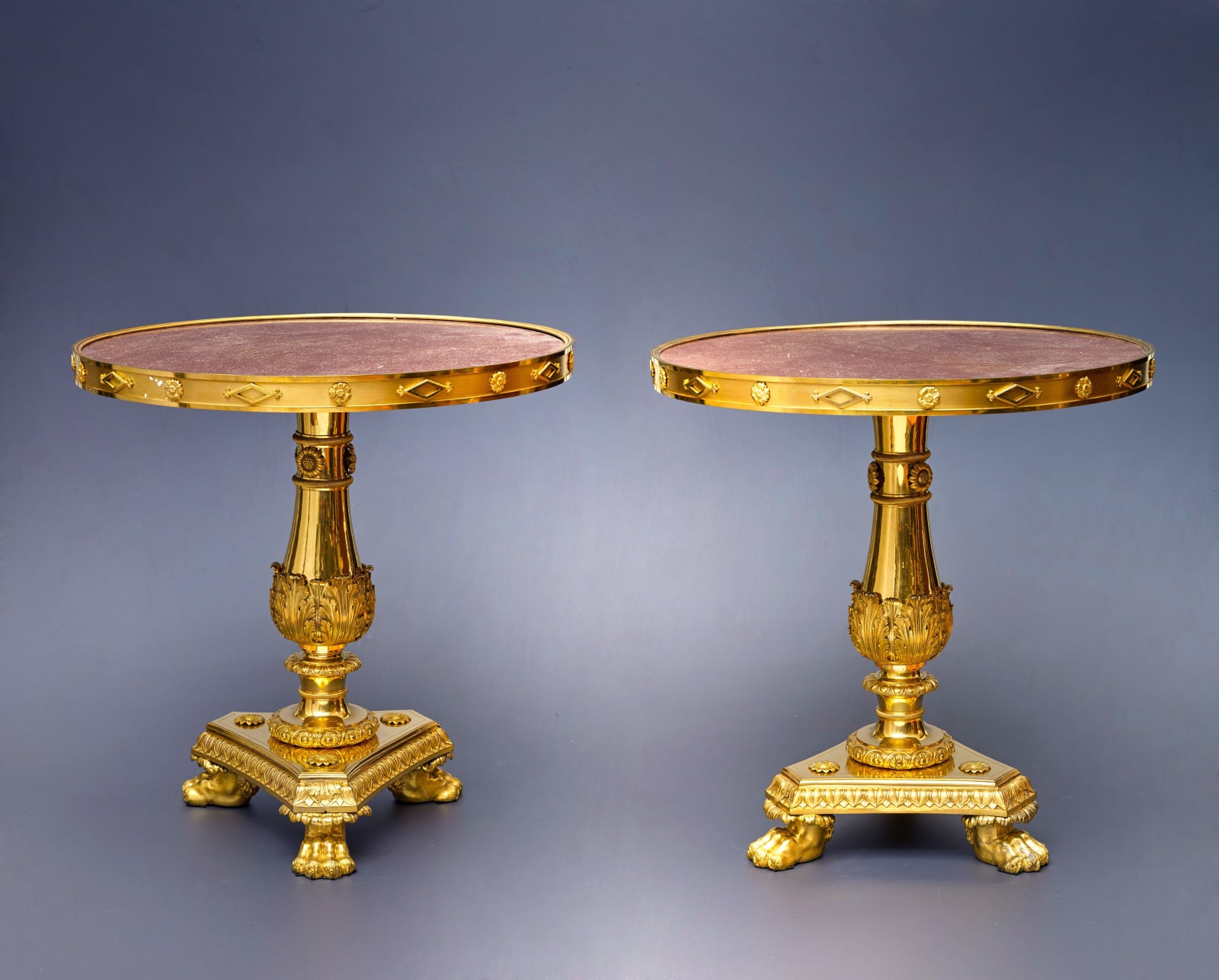Pierre-Philippe Thomire (attributed to) French, 1731-1843
Provenance
Until recently in a private Swiss collection.
A very fine pair of Restauration gilt bronze guéridons attributed to Pierre-Philippe Thomire, each with a circular dark red and white speckled porphyry top set within a gilt bronze border mounted with medallions and classical ornaments, upon a baluster-shaped support cast with rosettes, acanthus sprays and foliate rings upon a canted tripartite base ornamented on the top with three rosettes and on the sides with a foliate frieze and supported on three lion paw feet
Paris, date circa 1815-20
Height 71 cm. diameter 69 cm. each.
The quality and overall style of these superb guéridons are typical of the work of the esteemed fondeur-ciseleur Pierre-Philippe Thomire (1751-1843), comparing with a description of a signed example by Thomire, listed in the bronzier's inventories, as cited in J. Niclausse's monograph, "Thomire Fondeur-Ciseleur (1751-1843). Sa Vie, Son oeuvre", 1947, p. 134: Grand guéridon en bronze doré et ciselé La ceinture ronee est d'une succession d'etoiles, les pieds en se terminent handles. Signé Thomire. The description closely accords with the present pair. Similar guéridons were sold by Sotheby's, Monte Carlo on 3rd March 1990, lot 26 and at Christie's, New York on 8thMay 1991, lot 113.
Regarded as the leading fondeur-ciseleur of his day, Pierre-Philippe Thomire enjoyed the patronage of Louis XVI, Napoleon and Louis XVIII as well as foreign monarchy and aristocracy. Born in Paris, he began his training under the sculptors Jean-Antoine Houdon (1741-1828) and Augustin Pajou (1730-1809) at the Académie Saint-Luc, Paris and then followed his father's profession as a fondeur-ciseleur. He studied under the great fondeur-doreur Pierre Gouthière (1732-1813), from whom he acquired infinite skills in chasing and gilding, in particular matt gilding 'dorure au matt', to produce a subtle grainy satin-like finish as we see here which admirably contrasts with the more polished areas. Appointed a maître-fondeur in 1772, he set up his own business in 1776 following his collaboration with Jean-Louis Prieur in the decoration of the coronation coach for Louis XVI. His fame and notoriety was then propelled to even greater heights after the Revolution when in 1806 he became the first bronzier to be awarded a gold medal at the Exposition des Produits de l'Industrie. Three years later he won another gold medal and was also appointed ciseleur de l'Empereur.
By 1804 Thomire had purchased the extensive business of the marchand-mercier, Martin-Eloi Lignereux, which enabled him to operate on a broader basis, as a retailer of furniture and decorative objects as well as maker of bronzes and furniture. Thomire collaborated with three partners, renaming the business Thomire, Duterme & Cie, which rapidly achieved prominence and many Imperial commissions. But Thomire, like other Parisian firms suffered as a result of France's continuing wars; to avoid bankruptcy the firm was granted a dispensation to trade with the Prince Regent (later George IV of England). Despite their close association with the Imperial House, the firm survived Napoleon's downfall. Soon after 1815 the partnership with Duterme was dissolved and under its new style, Thomire et Cie flourished once more under the restored Bourbons. Pierre-Philippe Thomire retired in 1823 but continued to work as a sculptor and exhibited regularly at the Salon until 1834. After his retirement, Thomire's two sons-in-law Louis-Auguste-Cesar Carbonelle and André-Antoine Beauvisage ran the concern; they were then followed by Thomire's grandsons up until the firm's closure in 1852.
